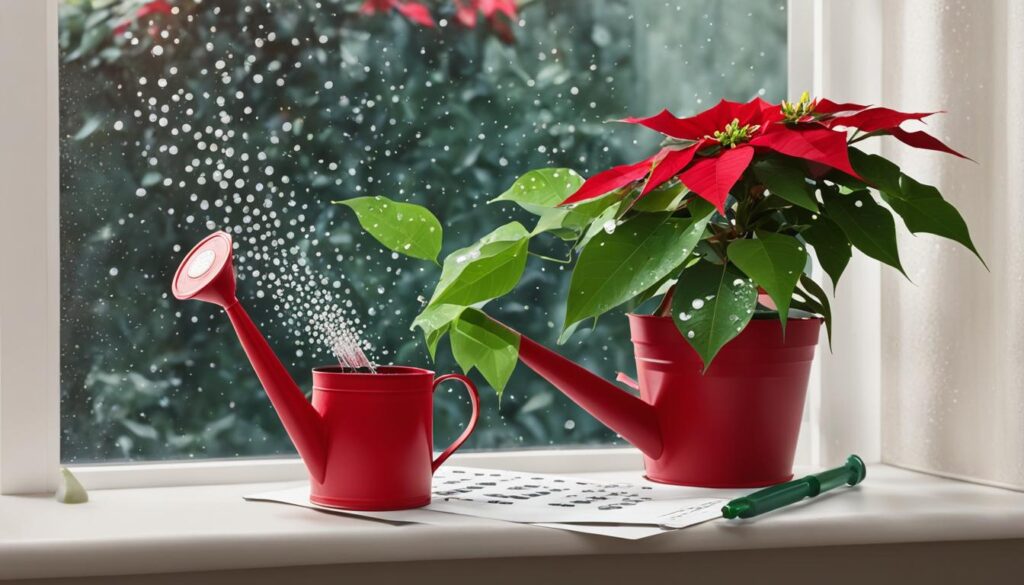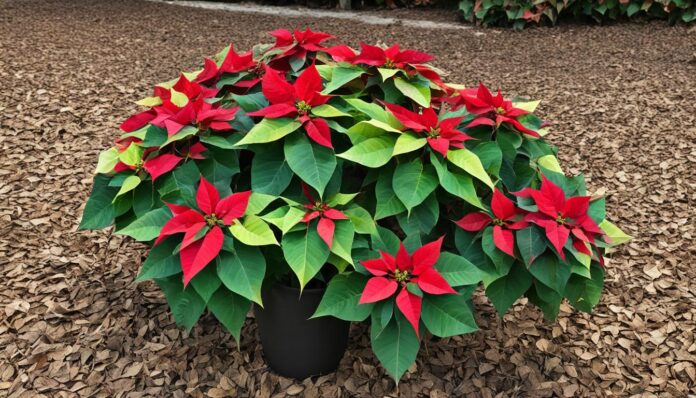Poinsettias, also known as Euphorbia pulcherrima, are popular decorative plants during the holiday season. Many people enjoy the vibrant red and green foliage that these plants bring to their indoor gardens. However, one common issue that poinsettia owners often encounter is leaf drop. It can be disheartening to see the beautiful leaves falling off, but rest assured, it is not necessarily fatal to the plant. Understanding the causes of poinsettia leaf drop and implementing the right care can help prevent excessive leaf loss and ensure the overall health of your plant.
Factors such as light, humidity, watering, temperature fluctuations, and environmental stressors can all contribute to leaf drop in poinsettias. By providing the plant with the right conditions and care, you can help keep your poinsettia healthy and minimize leaf drop. Let’s take a closer look at some of the possible reasons for poinsettia leaf drop, tips for preventing it, and how to revive a drooping poinsettia.
Key Takeaways:
- Leaf drop is a common issue in poinsettias during the holiday season.
- Factors such as light, humidity, watering, temperature fluctuations, and environmental stressors can contribute to leaf drop.
- Preventing poinsettia leaf drop involves providing proper care, including the right amount of light, humidity levels, and watering techniques.
- If your poinsettia is already drooping, you can take steps to revive it, such as adjusting watering and removing damaged leaves.
- Following best practices for poinsettia care, such as maintaining consistent light conditions and avoiding extreme temperature fluctuations, can help ensure a healthy plant.
Possible Reasons for Poinsettia Leaf Drop
Poinsettias are beautiful and festive plants commonly used for holiday decorations. However, if you notice your poinsettia dropping leaves, it’s important to understand the possible reasons behind this issue. Leaf drop in poinsettias can be caused by various factors, including environmental stress, temperature fluctuations, light conditions, humidity levels, and watering practices.
Environmental Stress
Environmental stressors, such as sudden changes in temperature or exposure to cold drafts, can lead to leaf drop in poinsettia plants. These stressors disrupt the plant’s natural growth processes and cause it to shed leaves as a survival mechanism.
Temperature Fluctuations
Poinsettias are sensitive to temperature extremes. Fluctuations in temperature, especially sudden drops or rises, can trigger leaf drop. It’s essential to keep your poinsettia away from drafty areas, cold windows, or heat sources that can subject the plant to drastic temperature changes.
Light Conditions
Poinsettias thrive in bright, indirect light. Insufficient light can result in weakened plants and leaf drop, while excessive exposure to direct sunlight can cause leaf scorching. Finding the right balance and providing your poinsettia with adequate light is crucial to prevent leaf drop.
Humidity Levels
Poinsettias prefer environments with moderate humidity. Low humidity can cause the leaves to dry out and drop, while excessively high humidity can promote fungal diseases. Maintaining a suitable humidity level, especially during the dry winter months, can help prevent leaf drop in poinsettias.
Watering Practices
Improper watering can also contribute to leaf drop in poinsettias. Overwatering can lead to root rot and suffocation, resulting in leaf loss. On the other hand, underwatering can cause the plant to wilt and shed its leaves. It’s essential to water poinsettias thoroughly but allow the soil to dry slightly between waterings to avoid waterlogged conditions.
Insect Infestations and Diseases
Poinsettias can be susceptible to insect infestations, such as aphids or whiteflies, and diseases like powdery mildew or root rot. These pests and diseases weaken the plant, making it more prone to leaf drop. Regular inspection and prompt treatment can help prevent the spread of pests and diseases and preserve the plant’s health.
Tips for Preventing Poinsettia Leaf Drop

Proper care is essential to prevent poinsettia leaf drop and keep your plant healthy throughout the holiday season. By following these care tips, you can ensure that your poinsettia thrives and maintains its beautiful foliage.
1. Provide the Right Light
Poinsettias require bright, indirect light to thrive. Place your plant in a location where it will receive at least six hours of bright, filtered sunlight per day. Avoid exposing it to direct sunlight, as this can scorch the leaves.
2. Maintain Humidity Levels
Poinsettias prefer a humid environment. Use a humidifier or place a shallow water tray filled with pebbles near the plant to increase humidity levels. As the water evaporates, it will create a humid microclimate around the plant.
3. Water Carefully
Proper watering techniques are crucial for preventing leaf drop in poinsettias. Water the plant when the top inch of the soil feels dry to the touch. Avoid overwatering, as excessive moisture can lead to root rot and leaf drop. Similarly, underwatering can cause the plant to become stressed and shed leaves.
4. Control Temperature and Drafts
Poinsettias are sensitive to temperature fluctuations and drafts. Keep the plant away from cold drafts and protect it from extreme temperature changes. Maintain a consistent temperature between 65-75°F (18-24°C) to ensure optimal growth and prevent leaf drop.
5. Monitor for Pests and Diseases
Regularly inspect your poinsettia for signs of pests, such as aphids or whiteflies, and diseases like powdery mildew or botrytis. If detected, take immediate measures to control and eliminate these issues to prevent further stress on the plant and leaf drop.
By following these tips, you can create the ideal conditions for your poinsettia and minimize the risk of leaf drop. Remember to provide the right light, maintain humidity levels, water carefully, control temperature and drafts, and monitor for pests and diseases. With proper care, your poinsettia will stay healthy and vibrant throughout the holiday season.
How to Revive a Drooping Poinsettia
If your poinsettia is already showing signs of drooping or yellowing leaves, there are steps you can take to revive it. Start by assessing the watering technique used for your poinsettia. Adjust the watering frequency to ensure that the plant is neither overwatered nor underwatered. Proper watering is crucial for poinsettias to maintain their health and vibrant foliage.
Additionally, remove any drooping or yellowing leaves from the plant. By doing so, you redirect the plant’s energy towards new growth and encourage the development of healthy leaves.
If your poinsettia is particularly droopy and struggling to stay upright, consider providing additional support. A stake or other form of support can help the plant regain its upright form and prevent further drooping.
By following these steps and providing the necessary care and maintenance, your poinsettia has the potential to recover and produce new, healthy growth, bringing back its vibrant beauty.
Reviving a Drooping Poinsettia
| Steps to Revive a Drooping Poinsettia |
|---|
| Assess the watering technique |
| Adjust watering frequency |
| Remove drooping or yellowing leaves |
| Provide additional support |
Best Practices for Poinsettia Care
Keeping your poinsettia healthy and vibrant over the holiday season is essential for maintaining its beauty and longevity. By following these best practices for poinsettia care, you can ensure that your decorative plant thrives throughout the festivities and beyond.
First and foremost, it’s crucial to provide your poinsettia with consistent light conditions. These plants require indirect sunlight to flourish. Find a spot in your home that offers bright but filtered light, away from direct sources of heat or cold drafts.
In addition to lighting, maintaining proper humidity levels is vital for poinsettia health. These plants prefer higher humidity, which can be challenging to achieve in a dry indoor environment. Consider using a humidifier to increase moisture levels or place a water tray filled with pebbles beneath the potted plant to create a humid microclimate.
Regularly checking the soil moisture is another essential aspect of poinsettia care. Water your plant when the top inch of the soil feels dry to the touch, being careful not to overwater or let the soil dry out completely. Too much moisture can lead to root rot, while insufficient watering results in drooping leaves and wilting.
Lastly, protect your poinsettia from extreme temperature fluctuations and cold drafts. These plants prefer temperatures between 60-70°F (15-21°C) during the day and slightly cooler conditions at night. Avoid placing them near doors, windows, or heating vents that could expose them to cold drafts.
By following these best practices for poinsettia care, you’ll ensure that your holiday plant remains healthy and vibrant throughout the season. With proper attention to lighting, humidity, watering, and temperature control, your poinsettia will continue to be a stunning centerpiece in your holiday décor.
FAQ
What are some possible reasons for poinsettia leaf drop?
Poinsettia leaf drop can be caused by environmental stressors such as temperature fluctuations, exposure to cold drafts, and improper light levels. Low humidity, improper watering, insect infestations, and diseases can also contribute to leaf loss.
How can I prevent poinsettia leaf drop?
To prevent poinsettia leaf drop, provide the plant with the right amount of light, maintain humidity levels, water it properly, and avoid extreme temperature fluctuations. Inspect the plant regularly for pests and diseases and take appropriate measures to address any issues.
What should I do if my poinsettia starts drooping or has yellowing leaves?
If your poinsettia is drooping or has yellowing leaves, adjust the watering, remove any drooping or yellowing leaves, and provide additional support like a stake. These steps will help redirect the plant’s energy towards new growth and encourage recovery.
What are some best practices for poinsettia care?
To keep your poinsettia healthy, maintain consistent light conditions, monitor humidity levels, water the plant according to its needs, and protect it from extreme temperature fluctuations. Following these guidelines will ensure a vibrant and thriving poinsettia.

